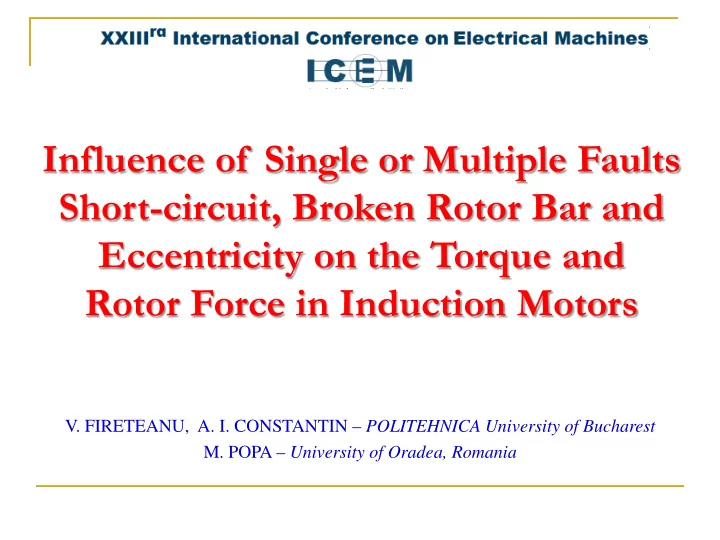

Influence of Single or Multiple Faults Short-circuit, Broken Rotor Bar and Eccentricity on the Torque and Rotor Force in Induction Motors V. FIRETEANU, A. I. CONSTANTIN – POLITEHNICA University of Bucharest M. POPA – University of Oradea, Romania
Summary Introduction Dedicated finite element models of the three faults: broken rotor bar, stator short-circuit and rotor static eccentricity Influence of single, double and triple faults on motor torque Influence of single, double and triple faults on rotor unbalanced force Results together Conclusions
3D finite element model of a squirrel-cage induction motor. Rotor bar breakage (BB) fault 7.5 kW two-poles squirrel-cage induction motor, 3 x 380 V, 50 Hz supply, 2880 rpm imposed rotor speed Healthy motor Resistivity of all rotor bars, ρ = 0.048 Ω mm 2 /m Rotor rar breakage simulation Increased resistivity 1.2 ρ , 2 ρ , 10 ρ , 10 2 ρ , 10 3 ρ , 10 7 ρ for FAR1, FAR2, FAR3, FAR4, FAR5, FAR6 faulty states
Stator short-circuit (SHC) fault Circuit model associated with the 3D finite element model Healthy motor state Rshc = 10 M Ω Stator short-circuit simulation Coils of the phase U of stator winding. Rshc = 90 Ω , 9.0 Ω , 5.0 Ω , 0.9 Ω , Elementary coil subject of the short- for FAS1, FAS2, FAS3, FAS4 circuit fault, in yellow faulty states
Rotor static eccentricity (ECC) fault Gap2 Gap1 Zoom Gap1 Zoom Gap2 Transversal symmetry plane of the computation domain Healthy motor state Static rotor eccentricity 20 % Gap1 = Gap2 = 0.50 mm Gap1 = 0.40 mm, Gap2 = 0.60 mm
Influence of Faults on Motor Torque
Influence of the single faults on motor torque (1-1) Signature of SHC fault in the torque time variation HF application Almost the same Mean value HF = 23.12 Nm results for SHC fault as for HE Healthy motor HE SHC faulty state
Influence of the single faults on motor torque (1-2) Signature of BB and ECC faults in the torque time variation Mean value LF = 15.67 Nm LF application Mean value HF = 16.07 Nm Mean value HF = 22.89 Nm HF application HF application BB faulty state ECC faulty state
Influence of the single faults on motor torque (1-3) Comparison HE, SHC, BB and ECC – the first three harmonics
Influence of the double faults on motor torque (2-1) Signature of SHC&BB fault in the torque time variation SHC&BB faulty state Healthy motor HE
Influence of the double faults on motor torque (2-2) Signature of BB&ECC and ECC&SHC faults in the torque time variation BB&ECC faulty state ECC&SHC faulty state
Influence of the double faults on motor torque (2-3) Comparison HE, SHC&BB, BB&ECC and ECC&SHC – the first three harmonics
Influence of the triple fault SHC&BB&ECC on motor torque
Influence of the triple fault SHC&BB&ECC Comparison SHC, BB, ECC and SHC&BB&ECC – the first three harmonics
Influence of Faults on Rotor Unbalanced Force
Influence of the single faults on rotor force (1-1) Signature of SHC fault in the rotor force time variation LF application LF application Mean value LF = 70.89 N Mean value LF = 20.78 N HF application Mean value HF = 70.41 N Healthy motor HE SHC faulty state
Influence of the single faults on rotor force (1-2) Signature of BB and ECC faults in the rotor force time variation LF application LF application Mean value LF = 197.3 N Mean value LF = 368.4 N HF application Mean value LF = 191.8 N BB faulty state ECC faulty state
Influence of the single faults on rotor force (1-3) Comparison HE, SHC, BB and ECC – the first three harmonics
Influence of the double faults on rotor force SHC&BB Most important five harmonics of rotor force time variation BB&ECC ECC&SHC
Influence of the triple fault SHC&BB&ECC on rotor unbalanced force
Influence of the triple fault SHC&BB&ECC on rotor unbalanced force Comparison SHC, BB, ECC and SHC&BB&ECC – the first three harmonics
RESULTS together
Mean value of the motor torque time variation
Amplitude of the most important motor torque harmonic
Mean value of the rotor force time variation
Amplitude of the most important harmonics of the rotor unbalanced force
Conclusions Only in the cases of broken bar fault, the triple fault and in the two double faults where the broken bar fault is present, the mean values of the motor torque are different from the (HE) case mean value. The harmonic 4 Hz of the motor torque has the highest value of the amplitude in all cases that include the broken bar fault. The stator short-circuit fault does not affect the amplitude of this harmonic, and the eccentricity generates a slight increase of the amplitude of this harmonic. The slotting harmonic 850 Hz of the motor torque is important in the healthy case and in all faulty cases without broken bar.
In contrast to motor torque, the mean values of the rotor unbalanced force present important increases in comparison with the healthy motor state even in case of the stator short- circuit fault. An important increase is generated by the eccentricity fault. However, the most important increase is associated with the broken bar fault. The harmonic of 4 Hz of the rotor force is the most important in the healthy case and in the broken bar case alone, or in association with the stator short-circuit. The most important harmonics of the rotor force generated by the stator short-circuit fault, alone or in association with the eccentricity fault, have the frequencies 200 Hz and 100 Hz. The eccentricity fault alone, in combination with the broken bar fault, or with the other two faults, is reflected in the rotor force harmonics of 60 Hz and 48 Hz.
The investigation methodology based on finite element analysis in time domain offers a deeper research of the electromagnetic phenomena in induction motors, in particular of the motor torque and of the rotor unbalanced force harmonics.
THANKS
Recommend
More recommend